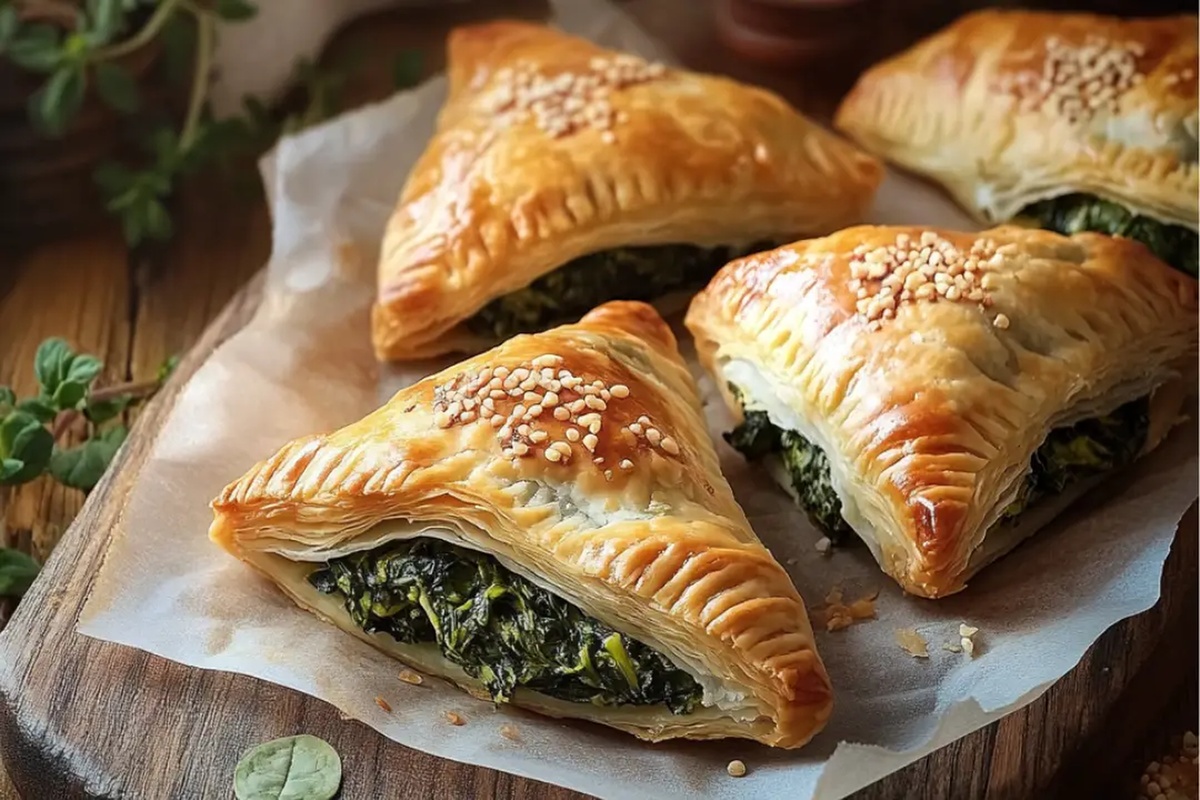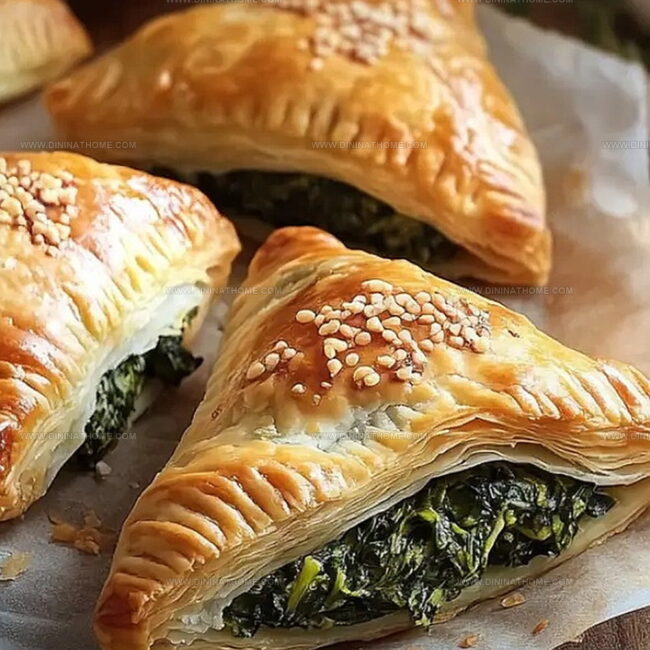Homemade Lebanese Spinach Pies (Fatayer) Recipe: A Tasty Treat
A crispy lebanese spinach pies delight might just become your next kitchen adventure.
Folding delicate dough around tangy filling takes practice and passion.
Spinach mixed with sumac and onions creates magic on plates.
Pastry skills matter less than pure enthusiasm for these treats.
Mediterranean kitchens buzz with generations of passed-down techniques for perfect pies.
Small pockets of flavor await your culinary exploration.
We know these bite-sized wonders will spark joy at your next gathering.
Why Lebanese Spinach Pies (Fatayer) Impress
What’s Included in Lebanese Spinach Pies (Fatayer)
Dough Ingredients:Filling Ingredients:Serving Suggestion:How to Prepare Traditional Lebanese Fatayer
Step 1: Activate Yeast Mixture
In a spacious mixing bowl, blend warm water, sugar, and yeast.
Allow the mixture to sit and become foamy, indicating active yeast.
Step 2: Create Dough Base
Incorporate flour and salt into the yeast mixture.
Stir until ingredients form a cohesive blend.
Transfer the developing dough onto a lightly floured workspace.
Step 3: Knead and Develop Texture
Work the dough by hand, pushing and folding for approximately 5 minutes.
The texture should feel slightly tacky.
Drizzle olive oil and continue kneading until the dough transforms into a soft, smooth consistency.
Step 4: Let Dough Rise
Place the dough in a greased container, cover with a clean kitchen towel.
Allow it to proof for 90 minutes until the volume doubles.
Step 5: Portion Dough
Divide the risen dough into 30 equal portions.
Shape each piece into a rounded ball.
Let the dough balls rest for an additional 30 minutes.
Step 6: Prepare Spinach Filling
Combine ingredients in a mixing bowl:Mix thoroughly and refrigerate until assembly time.
Step 7: Shape Fatayer
Preheat oven to 425°F.
Line baking sheets with parchment paper.
Flatten each dough ball into a circular shape.
Position 2 tablespoons of filling in the center.
Pinch two edges together, then fold the third edge to create a triangular shape.
Ensure all edges are securely sealed.
Step 8: Bake Until Golden
Arrange shaped fatayer on prepared baking sheets.
Bake for 15-20 minutes until they develop a beautiful golden-brown color.
Step 9: Serve and Enjoy
Transfer baked spinach pies to a serving platter.
Offer plain yogurt as an optional dipping companion for added flavor.
Authentic Prep Advice for Lebanese Spinach Pies
Save Lebanese Spinach Pies (Fatayer)
Tasty Companions for Lebanese Spinach Pies
Lebanese Spinach Pies (Fatayer) Filling Options
FAQs
Fatayer is a traditional Lebanese pastry that has been part of Middle Eastern cuisine for generations, typically served as a popular appetizer or snack in Lebanese households and restaurants.
Yes, this spinach fatayer is completely vegetarian, using fresh spinach, herbs, and plant-based ingredients without any meat or animal products.
Absolutely! You can prepare the dough in advance and refrigerate it overnight. Just let it come to room temperature and proof before shaping and filling the fatayer.
When you mix yeast with warm water and sugar, it should become frothy and bubbly within 5-10 minutes. If it doesn’t foam, your yeast might be expired or inactive.
Print
Lebanese Spinach Pies (Fatayer) Recipe
- Total Time: 50 minutes
- Yield: 12 1x
Description
Savory Lebanese spinach pies (fatayer) blend Mediterranean flavors with delicate pastry, creating a culinary journey through traditional Middle Eastern cuisine. Crisp, flaky dough embraces zesty spinach filling, inviting you to savor each delightful bite of this authentic Lebanese specialty.
Ingredients
Main Ingredients:
- 3 cups all-purpose flour
- 1.25 cups (1 1/4 cups) warm water
- 16 ounces (454 grams) frozen spinach, thawed and drained
- 1 medium onion, diced
Dry Ingredients:
- 2 teaspoons granulated sugar
- 2.25 teaspoons (2 1/4 teaspoons) instant yeast (1 packet)
- 2 teaspoons salt
- 1 tablespoon sumac
Liquid and Herbs Ingredients:
- 0.25 cup (1/4 cup) olive oil
- 2 tablespoons olive oil
- 0.25 cup (1/4 cup) parsley, chopped
- 2 tablespoons lemon juice
- 1 teaspoon salt
Instructions
- Activate the yeast mixture by combining warm water, sugar, and yeast in a mixing vessel. Allow the concoction to bloom and become frothy, indicating active fermentation.
- Incorporate flour and salt into the yeast mixture, blending thoroughly until a cohesive dough forms. Transfer the raw dough onto a lightly dusted work surface.
- Vigorously knead the dough for approximately 5 minutes, developing gluten and creating an elastic texture. Gradually introduce olive oil while continuing to manipulate the dough.
- Massage the dough until it achieves a silky, supple consistency with a gentle tackiness. Transfer the transformed dough into a greased container.
- Cover the dough and permit it to rise in a warm environment for 90 minutes, allowing it to expand and develop complex flavors.
- Partition the expanded dough into 30 uniform segments, rolling each into delicate spheres. Allow these dough balls to rest and relax for an additional 30 minutes.
- Prepare the filling by combining chopped spinach, finely minced parsley, diced onion, fruity olive oil, tangy lemon juice, aromatic sumac, and a precise salt seasoning.
- Refrigerate the filling mixture to maintain its crisp, fresh character until assembly time.
- Heat the oven to 425°F, positioning racks to ensure even thermal distribution. Line baking sheets with parchment paper for optimal performance.
- Gently flatten each dough sphere into a delicate circular shape. Strategically place a generous portion of filling at the center of each disk.
- Craft triangular pockets by meticulously pinching and folding dough edges, creating a sealed geometric parcel that encapsulates the vibrant filling.
- Arrange the assembled fatayer on prepared baking sheets, ensuring adequate spacing for optimal browning.
- Bake for 15-20 minutes, monitoring until the pastries transform into a golden, crisp exterior with a tantalizing aroma.
- Serve these Lebanese delicacies immediately, optionally accompanied by cool, creamy plain yogurt for a complementary dipping experience.
Notes
- Use fresh, vibrant spinach for the most authentic and flavorful filling, ensuring the leaves are thoroughly washed and well-drained to prevent soggy pies.
- Knead the dough patiently to develop gluten, which creates a soft, pillowy texture that’s crucial for traditional Lebanese fatayer.
- Allow sufficient proofing time for the dough, creating light and airy pastry that separates the delicate spinach filling from becoming dense or heavy.
- Experiment with alternative fillings like Swiss chard, feta cheese, or roasted vegetables to customize these versatile hand pies for different dietary preferences.
- Prep Time: 30 minutes
- Cook Time: 20 minutes
- Category: Lunch, Appetizer, Snacks
- Method: Baking
- Cuisine: Lebanese
Nutrition
- Serving Size: 12
- Calories: 210
- Sugar: 1 g
- Sodium: 320 mg
- Fat: 7 g
- Saturated Fat: 1 g
- Unsaturated Fat: 6 g
- Trans Fat: 0 g
- Carbohydrates: 32 g
- Fiber: 3 g
- Protein: 5 g
- Cholesterol: 0 mg




James Walker
Lead Recipe Developer & Culinary Educator
Expertise
Southern Cuisine & Farm-to-Table Cooking, Recipe Development & Testing, Culinary Education & Instruction
Education
School: Auguste Escoffier School of Culinary Arts
Program: Diploma in Culinary Arts and Operations
Focus: Comprehensive training in classical and modern culinary techniques, kitchen operations, and farm-to-table practices.
James didn’t learn cooking from a TV show, he learned it from busy kitchens, family gatherings, and long afternoons spent testing recipes the hard way.
After training at the Auguste Escoffier School of Culinary Arts, he brought his love for real, down-to-earth food to every dish he makes.
At Dining At Home, James loves building recipes that feel familiar but still have something special, like adding a twist to a classic or making a slow Sunday dinner feel brand new.
When he’s not in the kitchen, you’ll probably find him swapping garden tips at the farmers’ market or teaching his daughter how to flip pancakes without a mess (almost).